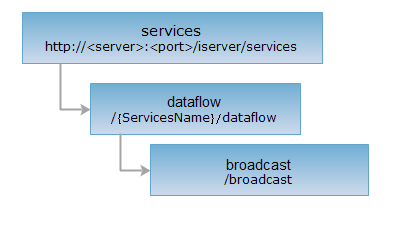URI
-
<dataflow_uri>/broadcast[.<format>]
-
ws://{ip}:{port}/iserver/services/{ServiceName}/dataflow/broadcast
Supported methods
Parent resource
Introduction
The broadcast resource is the entrance to data stream service which allows administrator to broadcast data to service users. Data in GeoJSON format can be accepted by broadcast resource.
Supported Methods:
- GET: Gets the broadcast entrance of data stream.
- POST: Broadcasts data to clients.
- HEAD: Checks whether the broadcast resource exists or whether it has permission to access the resource.
Supported output formats:rjson, json, html, xml.
Resource hierarchy

HTTP request methods
Implement the HTTP request on the following URI, where supermapiserver is the server name, with rjson being the output format.
http://supermapiserver:8090/iserver/services/{ServiceName}/dataflow/broadcast.rjson
GET request
Gets the broadcast entrance of data stream.
POST request
Broadcasts data to subscribers. Data is a Feature with time stamp.
HEAD request
Asks for the response identical to the one that would correspond to a GET request, but without the response body. This is useful for retrieving meta-information written in response headers, without having to transport the entire content. The meta-information includes the media-type, content-encoding, transfer-encoding, content-length, etc.
HEAD request can be used to check whether the broadcast resource exists, or whether the the client has the permission to access it. It can also determine if the broadcast resource supports an output format <format> if performed on a URI with .<format> included.
WebSocket Connection
Build a WebSocket connection, where supermapiserver is the server name
ws://supermapiserver:8091/iserver/services/{ServiceName}/dataflow/broadcast
| Name | Type | Description |
| token | String | Authentication information in broadcast. SeeGET token |